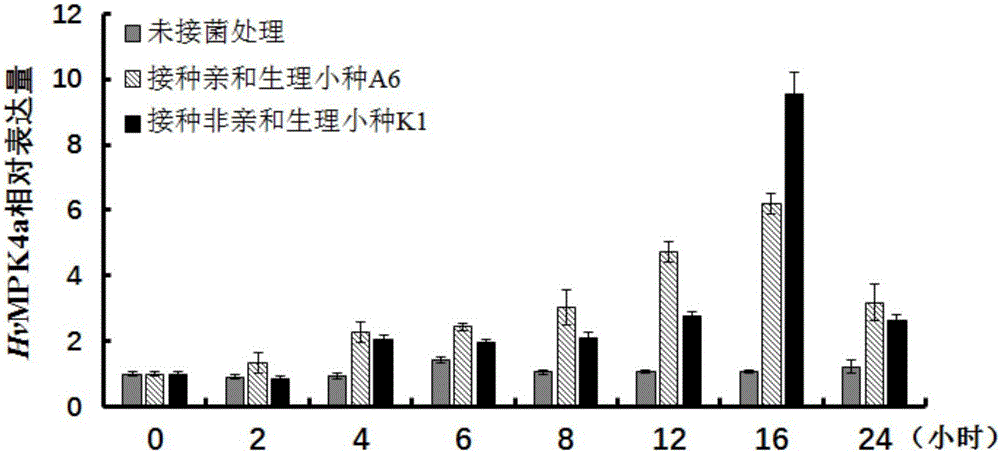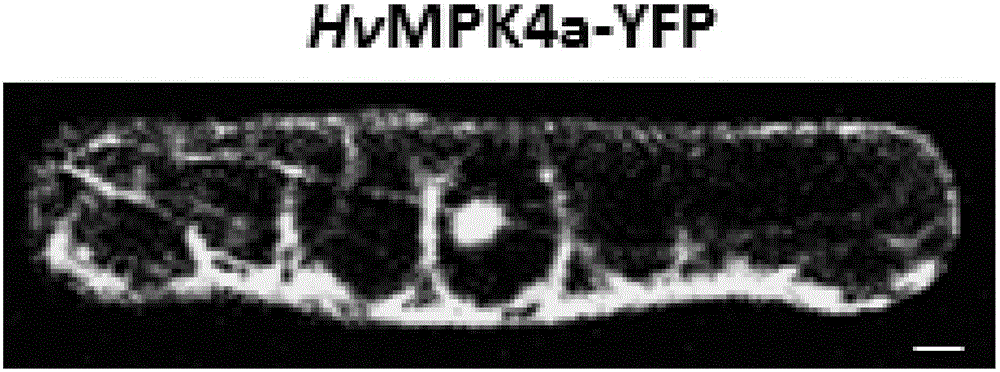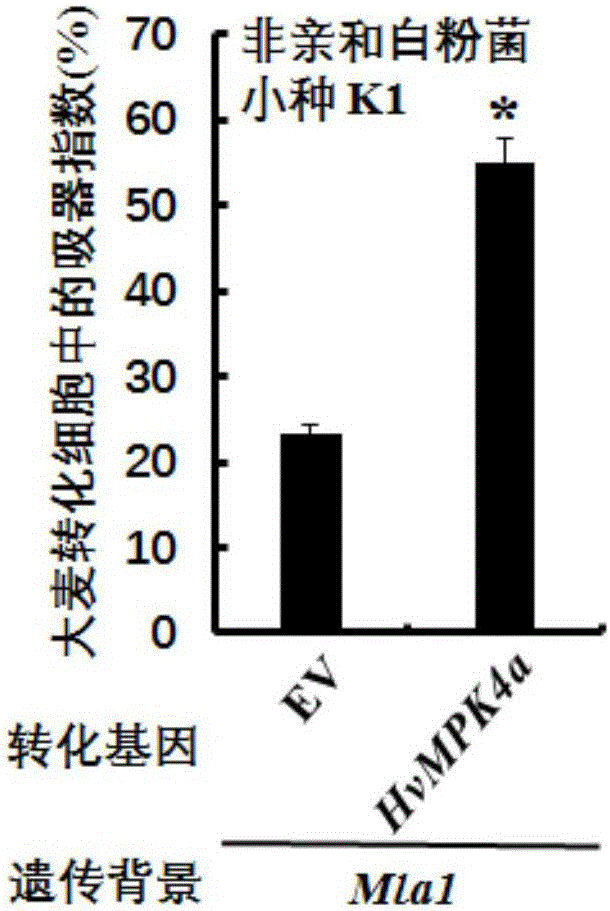Protein kinase HvMPK4a related to barley powdery mildew resistance and encoding gene and application of protein kinase HvMPK4a
A protein kinase, powdery mildew resistance technology, applied in application, genetic engineering, plant genetic improvement and other directions, can solve problems such as phytotoxicity, affecting crop yield and quality, and achieve the effect of enhancing resistance, improving and improving germplasm resources
- Summary
- Abstract
- Description
- Claims
- Application Information
AI Technical Summary
Problems solved by technology
Method used
Image
Examples
Embodiment 1
[0053] Example 1 Expression profile analysis of HvMPK4a during the infection of barley by Erysipha hordei
[0054] 1. Preparation of plant material.
[0055] After the seeds of barley variety P01 are sown, wait for about 1 week, cut off the flag leaves, and place them on a petri dish containing a medium (1% agar, 100mg / L bemimidazole), and recover for 24 hours. Physiological race K1 or A6 of powdery mildew of barley were inoculated respectively, and leaf materials were collected at different time points after inoculation.
[0056] 2. Extraction of plant total RNA.
[0057] Grind 300 mg of barley leaves quickly in liquid nitrogen to powder, add 1 mL of TRizol, shake well and centrifuge at 12,000 rpm at 4°C for 10 minutes; transfer the supernatant to a new centrifuge tube, add 1 / 5 of the volume of TRizol in chloroform, and mix well at room temperature Let it stand for 3 minutes to wait for its separation, and then centrifuge at 12000g for 15 minutes at 4°C. Transfer the super...
Embodiment 2
[0065] Cloning of embodiment 2 barley HvMPK4a gene and its localization analysis in barley cells
[0066] 1. Cloning of HvMPK4a gene.
[0067] The 7-day-old seedling leaves of barley variety GP were taken, RNA was extracted, and cDNA was obtained by reverse transcription. The reverse transcription system and process are as follows: RNA 2 μg, Oligo-dT 1 μL, add DEPC-H 2From 0 to 12 μL, mix the above solution in a centrifuge tube, denature at 70°C for 10 minutes, then cool on ice for 2 minutes, then add 2 μL of M-MLVBuffer, 1 μL of dNTPmix, 0.5 μL of RNase inhibitor, 1 μL of M-MLV, and add DEPC-H to the centrifuge tube 2 O to 20 μL, incubate at 42°C for 1 hour, and incubate at 70°C for 15 minutes to obtain reverse-transcribed cDNA.
[0068] The primers required for the PCR amplification of the cloned HvMPK4a gene are as follows:
[0069] Forward: 5'-ATGGACACCTCCGGCGGCGGCGGC-3';
[0070] Reverse: 5'-GTAGGGCGGATCAGGGTTAAAT-3'.
[0071] The PCR reaction system is: KODbuffer 5μ...
Embodiment 3
[0083] Example 3 Overexpression of HvMPK4a in Barley Epidermis Cells Resistance to Barley Powdery Mildew
[0084] 1. Carrier construction.
[0085] The full length of the above-mentioned HvMPK4a gene was constructed into the pUBI-Adaptor-NOS vector by enzyme digestion and ligation to generate pUbi-HvMPK4a.
[0086] 2. Transient overexpression of pUbi-HvMPK4a mediated by particle gun.
[0087] Gold powder was prepared as indicated above. Mix the plasmid DNA and the GUS reporter gene expression plasmid pUbi-GUS equimolarly, add deionized water to 5 μL; add the plasmid DNA mixture to 50 μL gold powder, and add 50 μL 2.5 M CaCl dropwise while shaking 2 , and then quickly add 20 μL 0.1M spermidine, and continue shaking for 3 minutes. Let stand for 1 minute to settle, centrifuge for 2 seconds, discard the supernatant, wash with 140 μL 70% ethanol and 140 μL 100% ethanol respectively, then add 12 μL 100% ethanol and shake and mix well.
[0088] 3. Inoculate powdery mildew and cou...
PUM
 Login to View More
Login to View More Abstract
Description
Claims
Application Information
 Login to View More
Login to View More - R&D
- Intellectual Property
- Life Sciences
- Materials
- Tech Scout
- Unparalleled Data Quality
- Higher Quality Content
- 60% Fewer Hallucinations
Browse by: Latest US Patents, China's latest patents, Technical Efficacy Thesaurus, Application Domain, Technology Topic, Popular Technical Reports.
© 2025 PatSnap. All rights reserved.Legal|Privacy policy|Modern Slavery Act Transparency Statement|Sitemap|About US| Contact US: help@patsnap.com



